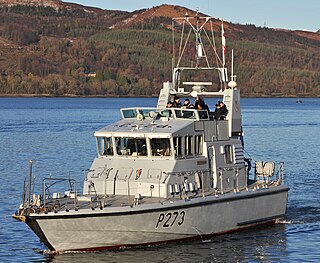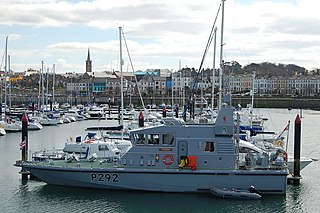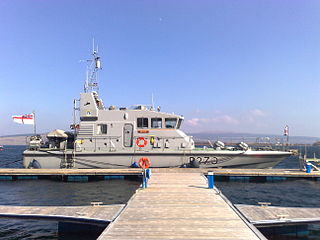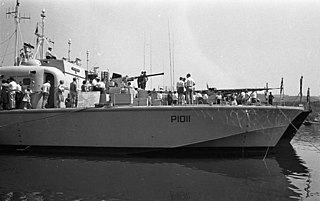Seven ships of the Royal Navy have been named HMS Archer, named after a person proficient in archery - an archer:

A motor torpedo boat is a fast torpedo boat, especially of the mid 20th century. The motor in the designation originally referred to their use of petrol engines, typically marinised aircraft engines or their derivatives, which distinguished them from other naval craft of the era, including other torpedo boats, that used steam turbines or reciprocating steam engines. Later, diesel-powered torpedo boats appeared, in turn or retroactively referred to as "motor torpedo boats" for their internal combustion engines, as distinct from steam powered reciprocating or turbine propulsion.

The Gibraltar Squadron is a unit of the British Royal Navy. It is the only seagoing Royal Naval unit based in Gibraltar, attached to British Forces Gibraltar. It currently includes two Cutlass-class fast patrol boats with a maximum speed of up to 41-knots. The first new vessel of this class, HMS Cutlass, arrived in Gibraltar in November 2021, followed by the second vessel, HMS Dagger, in March 2022. The squadron also uses three Pacific 24 rigid-hulled inflatable boats, crewed by a team of 26 people and deploys one diving support boat. The 2021 defence white paper indicated that henceforth, one River-class offshore patrol vessel, HMS Trent, would also be permanently based in Gibraltar for operations in the Mediterranean and in the Gulf of Guinea.

HMS Tracker is an Archer-class (P2000) patrol and training vessel of the British Royal Navy. Along with the batch 2 Archer class, HMS Raider, Tracker is part of the Faslane Patrol Boat Squadron based at HMNB Clyde.

HMS Archer is the lead ship of the Archer class. As the lead ship she was one of several of her class to be completed in 1985 by Watercraft Marine, the original shipbuilders — most of the remaining vessels were completed or built by Vosper Thornycroft. In 2015, she was one of the first of her class to receive an upgrade.

HMS Pursuer is an Archer-class P2000 patrol and training vessel of the Royal Navy.

HMS Severn is a River-class offshore patrol vessel of the Royal Navy. Named after the River Severn, the ship is the first to bear the name in 56 years. She was built by Vosper Thornycroft in Southampton, England, to serve primarily as a fishery protection unit within the United Kingdom's waters along with her two sister ships Mersey and Tyne. All three were commissioned into service in 2003 to replace the five older Island-class patrol vessels. The ship was decommissioned in 2017, but the Government decided to recommission her as part of Brexit preparedness. She returned to service in 2020 and was recommissioned into the Royal Navy on 28 August 2021.
Vosper & Company, often referred to simply as Vospers, was a British shipbuilding company based in Portsmouth, England.
HMS Exploit is an Archer-class patrol vessel of the British Royal Navy, built in Woolston by Vosper Thornycroft and commissioned in 1988. She is assigned to the Royal Navy Coastal Forces Squadron, carrying out a range of activities both in the U.K. and overseas.

The Archer class is a class of patrol and training vessel in service with the United Kingdom's Royal Navy, commonly referred to as a "fast training boat". Most are assigned to Coastal Forces Squadron. HMS Tracker and HMS Raider are armed and provide maritime force protection to high value shipping in the Firth of Clyde and are most commonly employed as escorts for submarines transiting to Faslane. Pursuer and Dasher were also armed during their deployment on maritime force protection duties with the Gibraltar Squadron from 2020-2022.

HMS Dasher is an Archer-class P2000 patrol and training vessel of the British Royal Navy. Dasher was built at Vosper Thorneycroft and commissioned in 1988.

HMS Charger is an Archer-class patrol vessel built by Watercraft Limited, Shoreham-by-Sea and fitted out at Vosper Thornycroft. She is just over 20 metres long and 5.8 metres wide and powered by two Rolls-Royce turbo engines. The ship is based at HMS Eaglet, the Royal Naval Headquarters in Liverpool and was commissioned in 1988. She has five full-time RN crew, and sails with an RNR training officer and a maximum complement of 12 students. She is attached to the Liverpool University Royal Naval Unit.

HMS Blazer is an Archer-class patrol vessel of the Royal Navy. She was built by Vosper Thornycroft. She is 20.8 metres long and 5.8 metres wide and powered by two Rolls-Royce diesel engines. The ship is based at HMS Nelson, the shore base in Portsmouth and was commissioned in 1988.

HMS Biter is an Archer-class P2000-type patrol and training vessel of the British Royal Navy. She is assigned to Manchester & Salford Universities Royal Naval Unit, a Royal Naval Reserve unit based in Manchester. The ship is based at HMS Eaglet, the Royal Naval Headquarters in Liverpool. As part of her sea training programme, she often makes visits to local ports for ceremonial visits or occasions.

The Brave-class fast patrol boats were a class of two gas turbine motor torpedo boats (MTBs) that were the last of their type for the Royal Navy (RN) Coastal Forces division. They formed the basis for a series of simpler boats which were widely built for export.

Coastal Forces was a division of the Royal Navy initially established during World War I, and then again in World War II under the command of Rear-Admiral, Coastal Forces. It remained active until the last minesweepers to wear the "HM Coastal Forces" cap tally were taken out of reserve in 1968. On 21 May 2020, ministerial approval for the change in name from 1st Patrol Boat Squadron to Coastal Forces Squadron was given. It encompasses the Archer-class patrol vessels and the Batch 1 River-class offshore patrol vessels and are responsible for UKEEZ Protection and Patrol.

The Gay class were a class of twelve fast patrol boats that served with the Royal Navy from the early 1950s. All were named after types of soldiers or military or related figures, prefixed with 'Gay'. The class could be fitted as either motor gun boats or motor torpedo boats, depending on the type of armament they carried.

HMS Gay Bombardier was a Gay-class fast patrol boat of the Royal Navy. She was built by Vosper, Portchester, and launched on 28 August 1952. She was the second ship to be launched in her class.

HMS Gay Bruiser was a Gay-class fast patrol boat of the Royal Navy. She was built by Vosper, Portchester, and launched on 19 December 1952. She was the third ship to be launched in her class.













